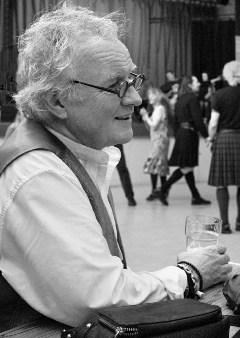From the Archive - December 2013
Not exactly archive this issue, more recollection. Mike Rowan, founder of the LBPS, recalls how it all began.

Mike at the Peebles Ceilidh, Nov 2013
It’s thankfully quite rare now but in the 60’s there was a breed of folk singer that daintily sang country songs with perfect enunciation. Not a bawdy song in sight. Twee, refined voices singing jolly country songs all about the hills, glens, and Lochs. And totally removed from real life. The Kenneth McKellar style of folk music irritated me enormously.
Similarly I found accordions out of place in Scottish folk music, and a bit irritating too - they are clearly a relatively modern instrument - younger than the style of music they played. So I wondered where was the real music.
By 1977, at 30, I was immersed in all things mediaeval. I had taught myself to play the pipes (badly) with a self-made goose with one tenor drone. As Com- munity Director of Theatre Workshop Edinburgh, I had produced, and per- formed in, two travelling “Troubadour” shows along with John Sampson and Rab Handleigh, one round villages in East Lothian and the other round Fife.
That year I also bought and restored a fifteenth century ruin, Mains Castle East Kilbride, and lived in it. The build- ing was a tower house, 40 feet long, 30 feet wide and 55 feet high. The walls were 6 feet thick on three sides and 10 feet thick on the fourth. The Great Hall (above the barrel vault) on the second floor, was big enough for two eightsome reels, so we had a lot of parties. I wanted to get the music right, I enjoyed David Munrow’s mediaeval LP’s, but where was the Scottish music?
In 1979 I found an LP of Jack Arm- strong playing the Northumberland pipes. Wonderful, joyful music. I got a set made for me, and from the maker found out that Scotland had its own version of bellows blown, “Half Long” pipes, but I’d never even seen a picture of them, let alone an actual set. I joined the Northumbrian Pipers Society and went to their meetings in Newcastle and to the delightful Rothbury Festival. I could see how the society was propagating the playing of their sweet pipes. Even far round the world. Colin Ross was hugely enthusiastic, as was Robbie Greensit. For the Northumbrian piper there was a splendid support system, makers, music researchers, historians, teachers and lots of players. Lord Arm- strong still even kept his own piper, an unbroken line. Scotland had none of this.
Then somewhere I saw a copy of de Witt’s “Lowland Wedding” and in that picture there appeared to be the instru- ment I was looking for - a smaller set of pipes that weren’t “Great Highland” and had a common stock. In looking for the original picture I came across an old but unplayable set in the Portrait Gallery in Queen St, Edinburgh. There was very little information about them and I had to find out more, so I asked to speak to the curator, Hugh Cheape. He told me that as far as he knew there was only one person with a playable set, Gordon Mooney, and he had turned his set from aluminium because he knew how to turn in aluminium! (We later discovered that there were four lowland pipers at the time, Gordon Mooney, Rab Wallace, Iain MacInnes, and the lovely Jimmy Wilson, none of them knowing each other).
I went to see Gordon in Linlithgow and discovered that he had also been researching lowland pipe music. Both Hugh and Gordon were good pipers and had connections with other enthusiasts, so I suggested we call a meeting. Hugh, with his historical knowledge, and his understanding of the Gaidhealtachd, Gordon, with his feel for the pipes (having made his own) and his considerable knowledge of the music, and me, with my enthusiasm and knowledge of the Northumberland Pipers Society, made a good team.
We decided to call a meeting, in the McEwan Halls, as part of the Edinburgh Folk Festival on the 29th March 1981. Fifteen people turned up, which is quite spectacular seeing that I had only sent out the invitations on 24th! Robbie Greensit came to one of the early meetings and offered to make a set, so I asked him to make me a Lowland set. We were off. Word spread remarkably quickly, it still took two years till we had 123 members round the world, but now we have around 350 worldwide and many more players than members.
It was delightful to see so many of those early faces at the Collogue at the beginning of November this year. People that have been the driving force through the years, Hamish, our wonderful Chairman, ‘Fixer’ and maker extraordinaire, dedicated Jeannie, Julian experimenting and making beautifully, Paul Roberts playing as sweetly as ever, Jock Agnew and David Hannay and many more. Through their persistence they have returned a nearly lost instrument back into our national culture.
At our recent collogue Hamish said that the founding of the LBPS had been the most influential occurrence in pip- ing since the formation of the Highland Regiments, and the more I think about it the more I realise that it’s true. Pipers are no longer restricted to THE one way of playing, it is now so much easier to play with other musicians, in different keys, there is such a variety of bellows pipes being made, and there is a whole new style of playing. We have broken the pipers’ mould. Hooray for us! Let’s keep spreading the word.
Mike’s enthusiasm for the Lowland and Border Piping tradition goes on unabated, as you can see from the following proposal he is making to the city of Stirling.
